Boatyard | Greyhawk | latest | next | 2006-07 | previous | oldest
GREYHAWK's wicked good adventure
Six men sailed a leaky little boat to Maine
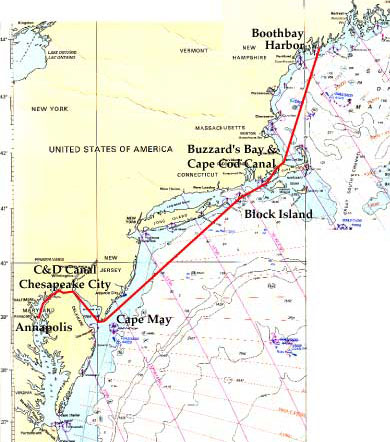
Sunday, June 25
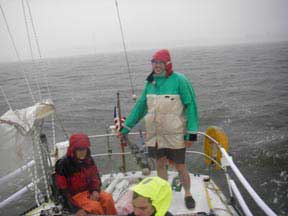
Starting off in Mill Creek: Tim at the helm, Dan and Scott struggling to stay dry
As soon as we departed the dock on Mill Creek in Annapolis at 8:50, the skies opened up with a great downpour. This set the tone for the rest of the day, and the rest of the trip -- it would be wet! But we didn't mind too much, as we were setting out on a grand adventure (and we were well prepared with foul weather gear). We had been planning and preparing for this voyage for almost a year.
The winds were out of the east which made for an easy reach up Chesapeake Bay, and we anchored in the basin at Chesapeake City on the C&D Canal at about 19:00 and grilled burgers over charcoal during a break in the showers.
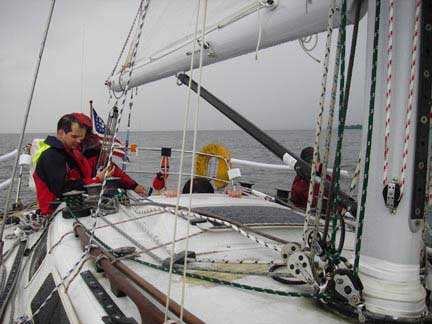
Reaching up the Chesapeake: Scott, Dan at the helm, Torrey behind the vang
Monday, June 26
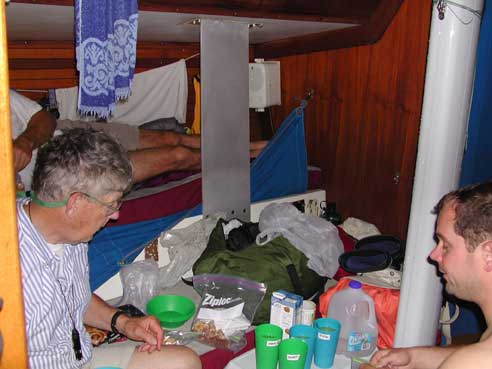
Dan serving up breakfast to Scott, with Charlie reclining in the pilot berth behind.
We got underway about 7:30 and motored through the C&D Canal with a favorable current, entering the Delaware River shortly after 9:00. The winds were out of the southeast, and initially the tide would be against us as well, but we set the sails, cut the engine, and begin the hard work of beating down Delaware Bay.
We did have to rebuild the head pump twice, as the piston kept falling off the end of the plunger rod. Some loc-tite did the trick. (A new head and plumbing is on the work schedule for this coming winter!)
When the tide turned in our favor later in the day, we were beating into big square waves close together, short tacking to avoid shoals and ships. Delaware Bay at its finest! The winds were gusting to over 25 knots, and even with double reefed main and jib well rolled up we were still sailing with the rail in the water much of the time. The checkstays came in quite handy keeping my noodley mast from pumping. The lazy checkstay was left just loose enough so as not to interfere with sail shape, and there's not much to take up when tacking (you want just enough tension to keep the mast in column).
With the rain and deck leaks, occasional seas being shipped over the boat, and some leaky plumbing in the engine compartment, the cabin sole was awash and we periodically hauled buckets up the companionway.
After clearing Mia Maull shoal, we made for the beach on the west side of the Cape May peninsula trying to find a little bit of a lee. We dropped the hook in 15 feet of water just off the beach at about midnight.
Tuesday, June 27
One of the crew cooked up some hot dogs and beans for a late dinner, and I set the shallow and deep alarms on the depth sounder. Shortly after crawling into my pipe berth, the alarm went off.
I crawled back out of my berth, checked the GPS track plot (we hadn't moved much if at all), and then went on deck to see what was going on. Water depth was down to 12 feet, and the anchor rode led from the bow under the boat. I hauled in on it to find out where it was going, and chased it around to the rudder. We grabbed the bight heading to the anchor with the boathook, got it around a stern cleat, and the freed the bitter end of the rode and pulled it through the gap between the rudder and skeg. Then I lead the anchor rode back to the bow and cleated it off again. By the time I got back to the cockpit, the boat had swung around and fouled the rode on the rudder again. You see, the tide was flowing to the south along the beach at about four knots, judging from the rate the jellyfish were zooming by, and there wasn't enough windage aft on the boat for the wind to keep us off the rode.
So we freed the rode again, but this time left the boat hanging from the stern cleat. Then I got out the second anchor, chain, and rode and shackled them together. We let out all 200' of rode off the stern to the first anchor, and I lowered the second anchor off the bow. The plan was that we would winch ourselves back up 100' or so on the first anchor in order to set the second anchor off the bow. But as soon as the second was down it started pulling away from me! I looked back, and we were still tight on the stern anchor. Perhaps the bow was swinging around, or perhaps the tidal current had grabbed that second anchor and skidded it backwards over the hardpan bottom!
Finally, we were lying to bow and stern anchors led off in opposite directions and we were able to get back in our berths and sleep well. It was now about 3:30.
When we eventually awoke in the morning, the tidal current had subsided and we were hanging from the bow anchor in the stiff breeze. After a leisurely breakfast and pumping of the bilges, etc...., the crew payed out the bow rode while I hauled in on the stern anchor. When that finally came up, we motored up on the bow anchor, got that out, and got underway.
We motored down to the Cape May canal and into Cape May, clearing under the bridges with only a few feet to spare over our tall mast. We pulled into the Canyon Club Resort Marina for a pump out, to use the shore facilities, and get some ice. The holding tank bladder was full as it seems that when we switched the Y-valve to overboard discharge, it had not seated all the way, and sea water was able to get in to the holding tank. Either that, or we filled the holding tank through the vent, since we were sailing with the rail in the water much of the previous day.
With the tide falling we risked being stranded with our deep keel, so we got underway again at about 13:00. We motored through Cape May harbor and out the Cape May inlet. With the winds strong out of the southeast, there was a good swell coming in the inlet, which made for some impressive waves to punch through going over the bar.
We set our sails (double reefed main and full jib) and bore off on our course, a beam reach on starboard tack headed for Buzzard's Bay. The sun was shining, we had a good 15 knots of breeze, with seas of 3 to 4 feet or so, and we were making good 7 to 7.5 knots. One of the crew exclaimed "Now this is what I signed up for!" and the others all agreed. About the only thing that could have improved the afternoon, I thought, would have been to have our wives aboard sunning themselves on the decks.
I instructed the crew on the watch rotations for the night, and out to sea we went.
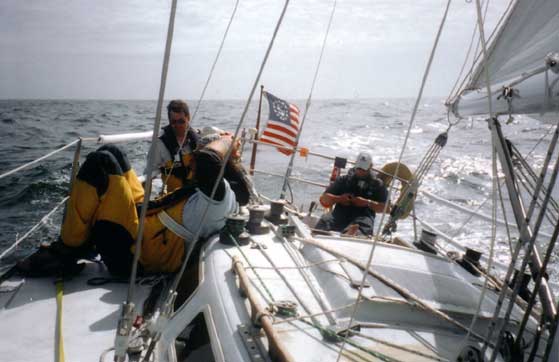
Somewhere off the New Jersey shore: Charlie watching the tug-barge on the horizon (which we overtook!), Tim on the helm, Scott checking our speed on his GPS
Wednesday, June 28
Through the night the winds and seas continued to build. When I came on deck about 4:30, we were making good 8.0 to 8.5 knots and things were getting harder to handle, so we rolled in some jib. As the sun started to rise, the winds got stronger and the seas higher still. We rolled in more jib (the main was already double-reefed).
Following instructions from SailRite, I had cut down the old #2 genoa (140%) that came with this new-to-me old racing boat so that it would fit on the new roller furler installed this winter. I added a foam luff pad as well, again following instructions from SailRite. I think this sail may have been relatively flat cut to begin with, but it really seems to keep a great shape when rolled up, even to the size of a #4. I think having a low clew height to begin with (this was a deck sweeping racing sail) and easily adjustable sheet lead positions helps.
The main is set up with "single-line" reefing -- I added ball-bearing blocks at the reef cringles (tacks and clews). We drop the halyard to the appropriate mark and take in on the reefing line which brings in both the tack and clew simultaneously. It works pretty well, and will be even better when I get slugs installed on the luff of the sail instead of the bolt rope (the bolt rope doesn't run back through the pre-feeder when pulling in the reefing line unless someone is at the mast the pull it through).
Soon, we ended up taking the "third-reef" in the main (i.e. dousing it all together) and sailing with just the jib alone, rolled up to #4 size. Our course was a close reach, and during the worst of it we were footing off a bit for a somewhat easier ride in the 12-foot "combers." When on top of a wave, looking out across the sea you could see the occasional wave popping up even higher. I guessed that conditions were Force 6 or 7; upon listening to the weather on the radio, the navigator reported that we were in a bona-fide Gale with winds of 35 knots and gusts up to 40.
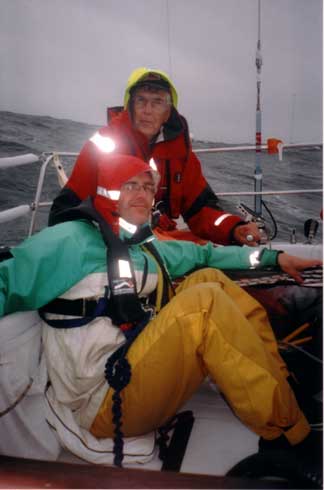
While the winds and seas were impressive, and I found myself contemplating what the next steps would be should the conditions get even heavier, the boat was really sailing very well (she's a great boat!) and I was having a great time. One of the crew later reported that he kept looking at me and the other experienced crew to see whether he should be scared or not. We of course found the sailing exhilarating, and so did he.
By evening, conditions had moderated significantly, the winds had shifted from southeast to south, and fog had set in. We had decided to press on to Marion, but wanted to make sure we arrived in daylight rather than at night, in the fog. After passing close by the rocks off Cuttyhunk Island (not seeing them in the dark of a foggy night, just hearing the surf), we bore off and ran wing-and-wing up to the ship channel, and then rolled up the jib all the way. We were going too fast! We took a second reef in the main, but were still making over 5 knots, so we over-trimmed the main to try to slow down further.
Thursday, June 29
We sailed into Sippican Harbor (Marion) and picked up a mooring just off the Beverly Yacht Club at about 5:30, and all turned in. We had just sailed about 260 nautical miles in about 40 hours. When we awoke a few hours later, we called the club on the radio to inquire about reciprocal privileges (one of the crew had a connection with the Annapolis Yacht Club). The response was that they don't do that (reciprocal privileges) but would gladly rent us a mooring for $40 and make us temporary members of their club giving us full use of all their facilities. Once we'ld got ourselves organized, we rode the launch ashore, took showers, and had lunch at the club. Four of the crew went off to town with the laundry, while the navigator and I went back out the boat to get it organized again (a lot of stuff had come un-stowed).
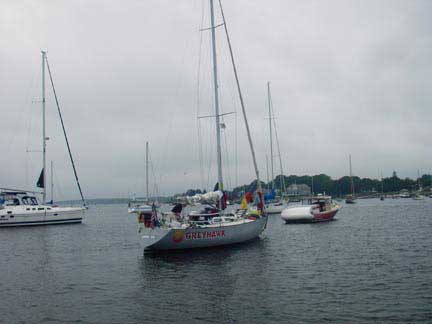
BYC Launch Driver: "Which boat?"
GREYHAWK crew: "The one with all the scarecrows on deck!"
We decided to stay on the mooring overnight and catch the tides through the Cape Cod Canal the next morning, rather than try to push on that evening. We ate dinner aboard the boat, and had a good night's sleep. The lay day was a well-earned respite, and the Beverly Yacht Club's hospitality was much appreciated.
Friday, June 30
We got underway at about 6:30 and followed a big Hinckley ketch out of the harbor heading for the Canal. They rolled out all sail, so we rolled out some jib, too. Entering the canal, we overtook them and soon rolled up our jib. Family friends waved to us as we passed the pier in Sandwich. We exited the canal and motored out into Cape Cod Bay on placid seas with a light southwesterly following us on our course for Boothbay Harbor. It was a beautiful sunny morning.

Photo by Dave Howes, Sandwich, MA
Within the hour, we set sail and cut the engine. Then we decided to rig the Spinnaker. This was exciting and required a fair bit of concentration on the part of the helmsman and the sheet trimmer. After a while, we doused the mainsail as it wasn't really helping push the boat and was just blanketing the Chute. Sailing under spinnaker alone, we were able to come up on our course and were often sailing by the lee (rather than gybing the pole over -- too much work ;-).
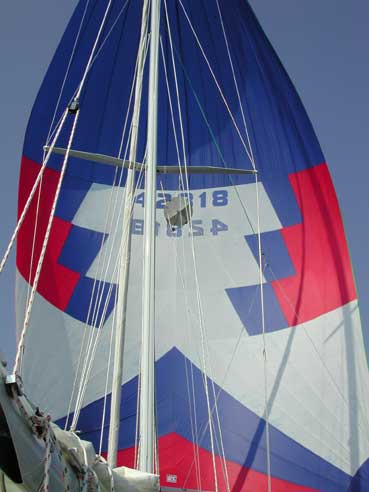
Sailing the Spinnaker by the lee.

Charlie trimming, Torrey helming, and Scott relaxing
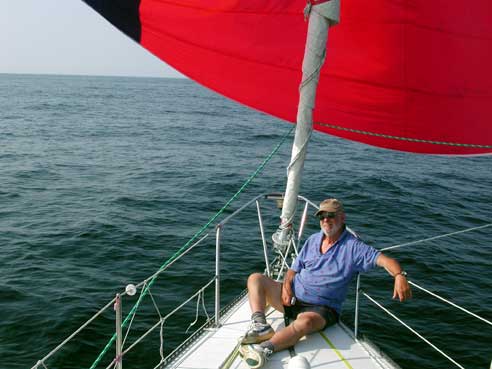
Rick resting at the bow
Just before sunset, we set the main, doused the spinnaker in its lee, and rolled out the jib, which we sheeted to the end of the spinnaker pole.
The crew were instructed on the watch rotation schedule, and I went below to rest up for my 02:00 watch. I was back on deck at 22:30, though, to help take in the pole. The winds had shifted to westerly, as expected, and we were now sailing on a fast reach again, this time on port tack.
Saturday, July 1
What a glorious night! We were beam reaching under a beautiful star-filled sky. The wind freshened just before sunrise and we reefed the main and jib. As we approached the Maine coast, conditions moderated again. We cleared the Cuckholds light at about 8:30, having sailed about 130 nautical miles in about 24 hours. We tied up at the Harborfields dock in West Boothbay Harbor at around 10:00 or so, but only after I had put the boat in irons trying to sail up the dock, drifted down on a lobster pot buoy which got caught between rudder and skeg, which in turn caused us to ground the keel on a rock.
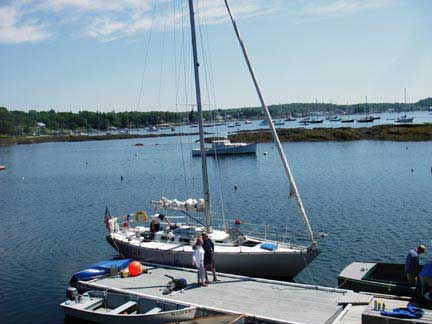
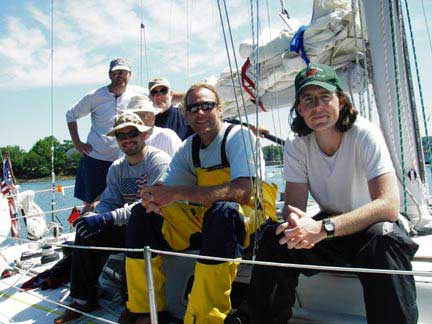
Six men sailed a leaky little boat to Maine...
In front from left to right, Scott, Charlie, Torrey
In back from left to right, Tim, Dan (behind Scott), Rick
ages range from 23 to 74!
We all agreed that this voyage had been a wicked good adventure, which afforded the crew a wide range of experiences. At one time or another, we had used just about all the rigging aboard, except for the Man Overboard gear. The boat had performed above expectations, despite all the annoying little leaks. The GPS trip meter indicated that we had sailed over 550 nautical miles at an average speed of over 5.7 knots. The engine was run for only about 9 hours 35 minutes total, mostly transitting the canals, and we used just over 5 gallons of fuel.
The crew cleaned out the boat, got showered, and made arrangements for transportation home. Two left when one's wife showed up frustrated by the holiday weekend traffic, and the four of us remaining went out to a late lunch -- captain's treat.
Boatyard | Greyhawk | latest | next | 2006-07 | previous | oldest
website by thorpeallen.net
March 2010